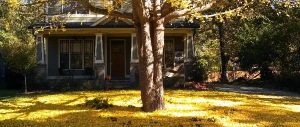Answering questions about Decatur’s tree canopy
The other day when I wrote about a public input meeting for the city’s new tree ordinance, which is still being drafted.
A couple of Decaturish readers had questions and I promised I would try to get city officials to answer them. Here’s what I learned.
In my story, I stated that Increasing canopy cover requires planting thousands of trees. In order to increase the canopy from 45 percent (using 2010 figures, mind) to 50 percent, you’d need to plant 3,660 “large canopy trees.” To get it up to 60 percent, you’d need to plant 10,980 of them.
Ben asked: Does the tree coverage proportion mean anything? I understand that 50% is better than 45%, but how much better, and by what measure? What do the residents of the City lose by having a 5% smaller canopy?
I’ve looked into the question and I am afraid the answer isn’t quite as simple as whether 50 percent is better than 45 percent, or whether 50 percent is better than 60 percent. People who support larger tree canopies and tree preservation ordinances say that it provides a whole range of benefits, from environmental to economic to cultural.
According to the Sustainable Cities Institute, trees provide shade and reduce the “heat island effect.”(Says SCI, “If you have ever walked across an un-shaded parking lot during the hot summer, then you have experienced the urban heat island effect. Large areas of asphalt and concrete trap the heat of the sun and reflect it back into the environment, thereby raising the temperature in surrounding areas.”)
Trees produce oxygen. They reduce stormwater runoff.
The benefit of increased canopy is an increase in all of the touted benefits of having trees. So 50 percent more canopy would mean more trees to help reduce “heat island effects”and whatnot. And 60 percent would help even more. I haven’t had the time to research counter-arguments to this, at least from the environmental perspective. (Much of what I found in my initial Google searches were arguments in favor of more canopy.)
There are broader philosophical arguments, like how much control government should have over what you do on your own property and whether property owners should have to consider the concerns of neighboring property owners. But that really has nothing to do with whether 50 percent more trees is better than 45 percent. I’d welcome any opinions that run counter to conventional wisdom on the positive environmental effects of trees. I’m sure it exists, but I haven’t found it yet. (Nice thing about living in 2013- there’s always a contrary view out there and you can find it if you dig deep enough.)
Question No. 2:
Erb asked: Was there any discussion of whether the proposed ordinance would only deal with new construction, or would it impact tree removal for all property owners across the board?
The city’s answer? There is no ordinance yet. The current process is designed to get input so the city’s consultant can write a draft ordinance to present to the Decatur City Commission in January.
Spokeswoman Casie Yoder said, “The city is at the listening stage about trees, so your readers should give their feedback at DecaturNext.com based on what feels right to them and what they value. This will all be used in the drafting of the proposed tree ordinance.”
According to Decatur Next’s recap of the Dec. 11 meeting:
“Afterwards came an opportunity for audience Q&A, at which time it became apparent that those in attendance were hungry for specifics. How will the ordinance be structured? What will property owners be allowed to do or not do?
“… Those answers aren’t available yet because the community opinions being provided during the evening’s participation exercise are what will ultimately tell the tale. Want improved canopy coverage? Write that down. Want to ensure your ability to build or renovate? Write it down.”
So unfortunately, there’s no answer to Erb’s question yet. We should know more when the draft ordinance becomes available in January. In the meantime, you can continue to submit your input by clicking here.
To Erb and Ben, I hope that helps. Thanks for the questions.

